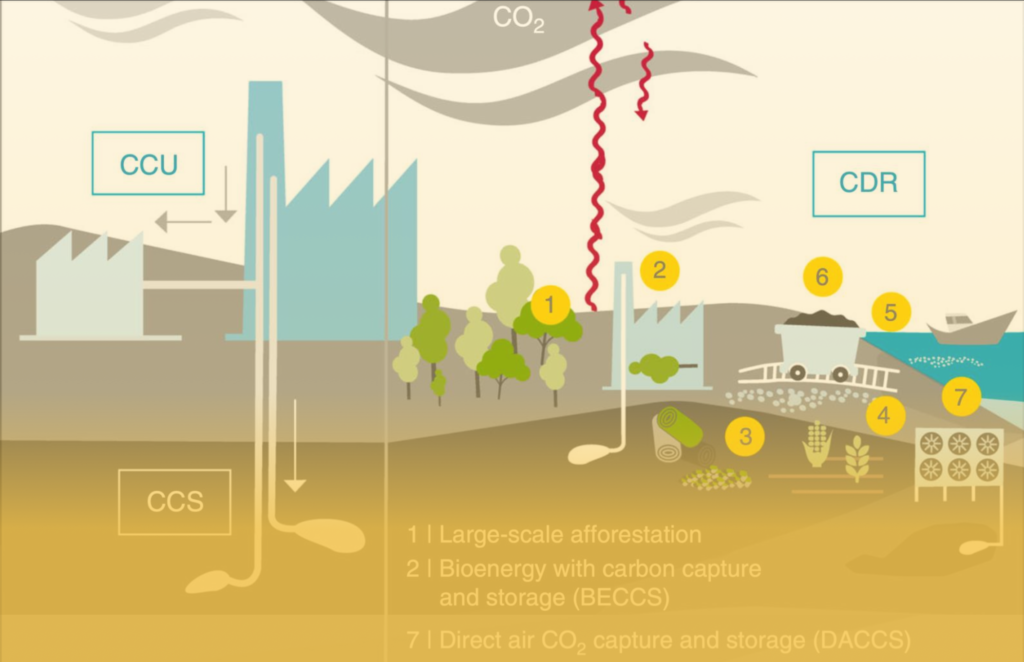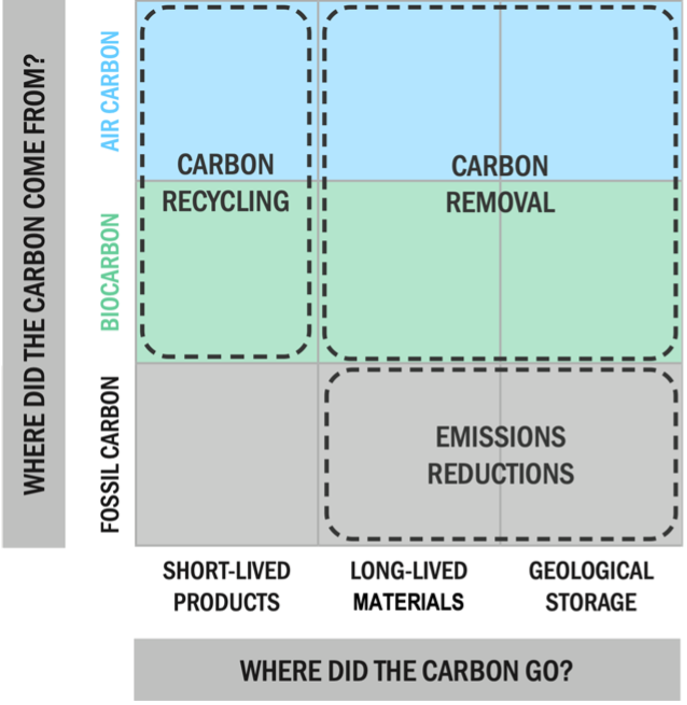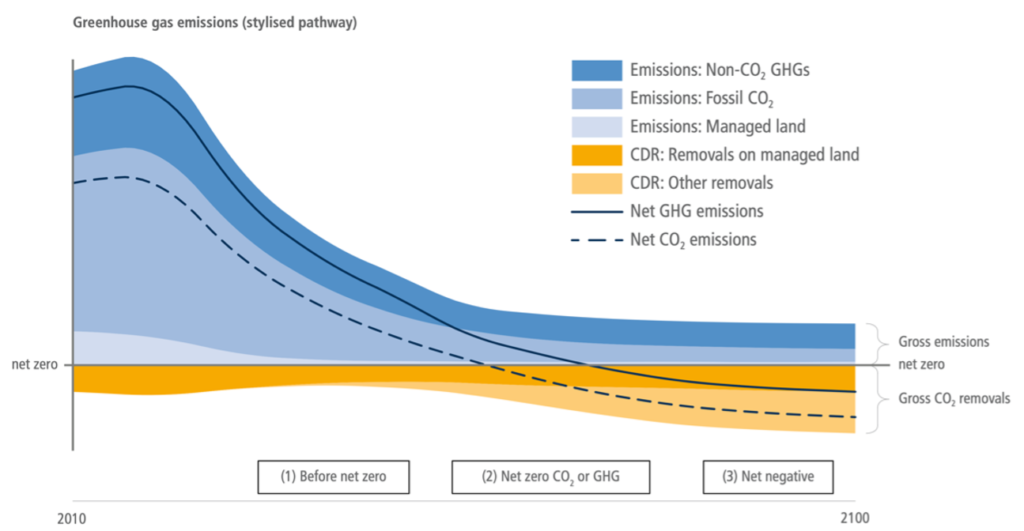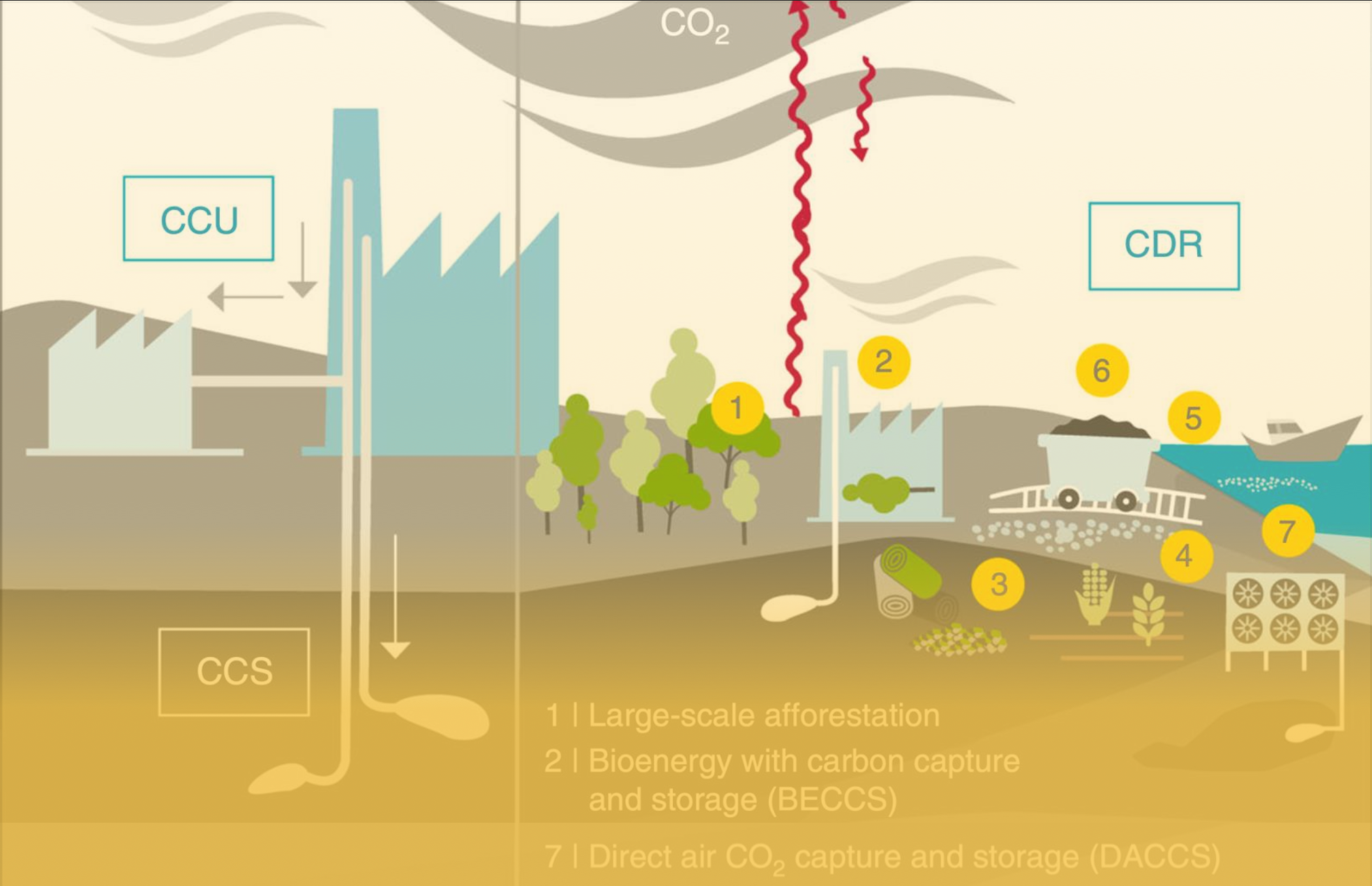Some negative emission technologies can potentially remove substantial quantities of air carbon in the long term. Their impact on climate change mitigation is yet uncertain. Requirements in land use, resources, and storage infrastructure pose a challenge. These and their risks to the environment and society need attention for sustainable carbon removals to materialize.
In this blog post series, I provide professionals in charge of climate policy or funding with the latest scientific insights into the global state, projections, and implications of two widely discussed technologies to remove carbon dioxide: Bioenergy with Carbon Capture and Storage (BECCS) in part II; and Direct Air Carbon Capture and Storage (DACCS) in part III. But first, in this part, I turn to the role of carbon dioxide removal.
The big picture
To limit global warming to well below 2°C, possibly to 1.5°C, carbon dioxide (CO2) emissions need to reach net zero by the middle of the century.[5] As emission reductions are delayed, CO2 needs to be removed from the ambient air to prevent dangerous climate change.[6] Indeed, models project significant carbon dioxide removals (CDR) for the future.[7] The problem: there are uncertainties that merit attention, i.e., the discrepancy between what is technically doable, economically viable, and socially feasibly. Because of that, projections may deflect attention from presently needed actions to swiftly reduce emissions as well as to upscale carbon removal.[8]
| Net zero | The “balance between anthropogenic emissions by sources and removals by sinks of greenhouse gases” (GHG).[2] |
| Carbon Dioxide Removal (CDR) | Removing CO2 from the air or biomass and storing it durably in geological formations, soils, ocean reservoirs, or long-lived materials.[3] |
| Negative Emission Technology (NET) | Technologies for CDR. Not commonly defined, they can cover the use of minerals to sequester CO2 above or underground (see Figure).[4] BECCS and DACCS are high impact/uncertainty technologies. A-/reforestation (A/R), a nature-based solution, can serve as benchmark. |
There are several carbon removal methods.[9] Importantly, methods to remove atmospheric carbon must be distinguished from those that merely capture (fossil) carbon at point sources. The latter serve to reduce emissions (see Figure).
Carbon Capture and Storage (CCS) vs. Carbon Dioxide Removal (CDR) [1] Carbon Dioxide Removal Matrix [10]  |
BECCS and DACCS are technologies that can prospectively remove substantial amounts of carbon permanently, but there are high uncertainties in their implementation. This has implications for the role of governance, funding, research, and development. Given the latency in policy and project cycles (long lead times), uncertainties need to be addressed today for these technologies to materialize as feasible solutions in the long term.
Role of Carbon Dioxide Removal
The remaining global carbon budget is shrinking. In 2021, 37 GtCO2 from fossil fuels were added to the atmosphere.[11] An estimated 500 Gt and 1,350 Gt of CO2 can be emitted—with a 50% chance due to possible feedback loops—before breaching the 1.5°C and 2°C goals, respectively.[12]
Emissions need to swiftly decline, reaching net zero by the middle of the century.[13] The fewer emissions are reduced, the more air carbon will have to be removed. Country pledges do neither sufficiently consider reductions,[14] nor cover several removal methods.[15] Contrary to af-/reforestation,[16] BECCS and DACCS are listed in a few strategies only.[17]
Scientifically, CDR methods are key for mitigation portfolios: to help reduce emission levels; to compensate hard-to-abate emissions and reach net zero at the country or global level; once used at scale, to help achieve net negative emissions and gradually revert warming (Figure).[18]
Pathway Illustrating Gross Emissions, CO2 Removals, Net Emissions[19] |
The challenge is to upscale CDR from the currently low levels to the required extent.[20] Modelled pathways in line with +1.5°C or +2°C warming depend on large removals.[21] Projections vary.[22] A total of 730 GtCO2 by 2100 is estimated to be removed across all scenarios (median).[23] Above 10 GtCO2 yr-1 (annually) must be removed by 2050.[24]
BECCS and DACCS are expected to remove in aggregate 357 GtCO2 by 2100 to still meet the global climate goal (A/R: 252 GtCO2; medians).[25] Projections, however, guarantee neither the technologies’ readiness nor these outcomes.[26]
Outlook
To reach mid-century net zero emissions, CDR is pivotal for mitigation strategies. Given the latest science in climate change and model projections, it is required alongside emission reductions, energy efficiency, and sustainable land use to limit global warming to 1.5°C or 2°C. BECCS and DACCS could have a high impact on mitigation, but there are high uncertainties for each due to physical, economic, and social constraints.
Studies arrive at different CDR potentials. Most of them require current capacities to increase by several orders of magnitude by 2050. Once at commercial scale, these technologies could sequester carbon in substantial quantities—especially for 1.5°C—and sequester it permanently—contrary to forestation.
Projections are not predictions. Challenges remain with respect to feedstock for BECCS, energy and cost in DACCS, and storage infrastructure for both. This has implications. Governance, regulation, funding, and R&D need to enable these technologies to take off, presumably starting with CCS, reducing their risks, so that they can help deliver the removals needed for net zero emissions.
[1] Lawrence, et al., 2018
[2] UNFCCC, 2015, Article 4; IPCC, 2021
[3] IPCC, 2022
[4] NASEM, 2019; IPCC, 2022
[5] IPCC, 2018; IPCC, 2021; IPCC, 2022
[6] NASEM, 2019
[7] Masson-Delmotte, et al., 2021; Shukla, et al., 2022
[8] Anderson/Peters, 2016; Beck/Mahony, 2018; Bellamy, 2018; Buck, 2016; Larkin, et al., 2018; Lenzi, 2018; Markusson, et al., 2018; Nemet, et al., 2018; Shue, 2018; Carton, 2019; NASEM, 2019; Grant, et al., 2021
[9] EASAC, 2018; Fuss, et al., 2018; Babiker, et al., 2022
[10] Morrow/Thompson, 2020, adjusted
[11] Our World in Data, 2022
[12] Masson-Delmotte, et al., 2021; cf. McKay, et al., 2022
[13] Masson-Delmotte, et al., 2021; Iyer, et al., 2021
[14] UNEP, 2022; UNFCCC, 2022a; UNFCCC, 2022b
[15] Schenuit, et al., 2021
[16] Moe/Røttereng, 2018; Fyson/Jeffery, 2019; Mace, et al., 2021
[17] Buylova, et al., 2021
[18] Lee, et al., 2021; Masson-Delmotte, et al., 2021; Babiker, et al., 2022
[19] Babiker, et al., 2022
[20] de Coninck, et al., 2018; Lawrence, et al., 2018; Nemet, et al., 2018; Hanna, et al., 2021
[21] 1.5°C >50%; 2.0°C >67% chance (Riahi, et al., 2022); Minx, et al., 2018
[22] EASAC, 2018; van Vuuren, 2018; NASEM, 2019
[23] de Coninck, et al., 2018; Rickels, et al., 2018; Rogelj, et al., 2018; Lee, et al., 2021
[24] NASEM, 2019; Sandalow, et al., 2021a
[25] Babiker, et al., 2022; Models emphasize A/R, BECCS, DACCS (Chen & Tavoni, 2013; Waisman, et al., 2014; Smith, et al., 2016; Marcucci, et al., 2017; Rogelj, et al., 2018; Fuhrman, et al., 2019; Realmonte, et al., 2019; Rickels, et al., 2019; Calvin, et al., 2021; Fuhrman, et al., 2021)
[26] EASAC, 2018

Leave a Reply